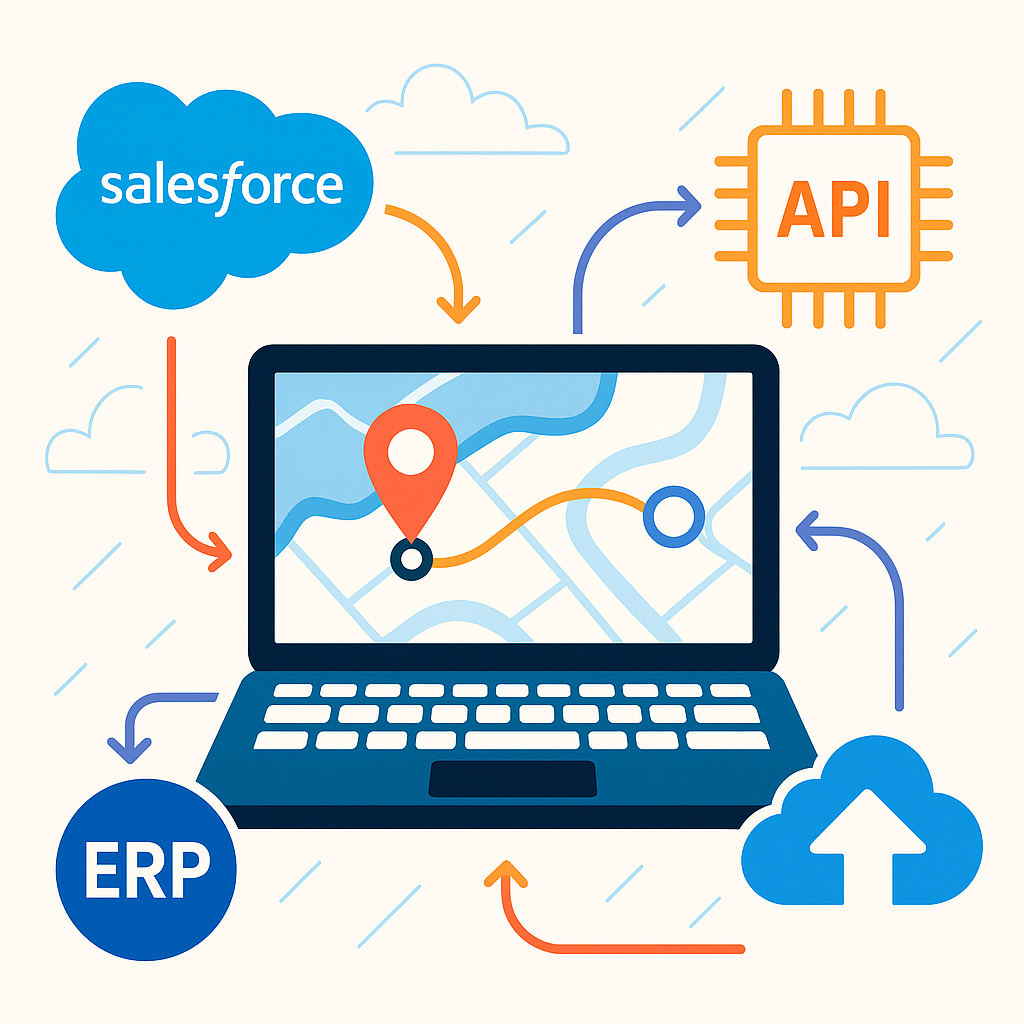Why Real-Time Shipment Visibility Matters
Shippers today face a common frustration: blind spots. Once freight leaves the dock, tracking often depends on delayed updates or separate carrier portals. The result? Missed ETAs, frustrated customers, and wasted hours chasing information.
With real-time shipment visibility, those blind spots disappear. Instead of juggling ten different carrier sites, shippers can unify tracking, compliance, and financial updates into one platform.

Core Technologies Powering Visibility
GPS, Telematics, and IoT Sensors
Solutions like Geotab and Samsara deliver live vehicle data: truck location, engine diagnostics, and driver behavior. Paired with IoT sensors, shippers can monitor temperature, humidity, and security conditions in real time.
➡️ FTM’s integration with Geotab
➡️ FTM’s integration with Samsara
Mapping & Routing Tools
Accurate ETAs require smarter routing. Google Maps, PC Miler, GraphHopper, and OpenStreet provide mileage, toll cost, and traffic-adjusted routing.
➡️ FTM’s integration with Google Maps
➡️ FTM’s integration with PC*Miler
➡️ FTM’s integration with GraphHopper
API & EDI File Transfer
Not every carrier is API-ready. That’s where EDI and XML transfers keep older systems connected — ensuring no shipment slips out of sight.
Key Integrations That Deliver Results
Visibility & Tracking Platforms
MacroPoint, Trucker Tools, TextLocate, MyCarrier Portal (MCP), Satrack → Automated GPS pings and status updates.
➡️ FTM Trucker Tools integration
Multi-Carrier & 3PL Connectivity
Direct integration with carriers like FedEx, UPS, DHL, XPO, Estes, R+L Carriers, and others ensures that shipment milestones flow natively into your TMS.
Compliance & Risk Management
RMIS, SaferWatch, and Highway integrations validate carriers before you book them, reducing risk and protecting customer trust.
Financial & Documentation Visibility
Tools like QuickBooks, AccountingSeed, Sage, Xero, HaulPay, Triumph, and HelloSign connect invoicing and proof-of-delivery directly to shipment milestones.
➡️ FTM AccountingSeed integration
Warehouse & WMS Visibility
With EnterSoft WMS and Primus, shippers connect freight inside warehouses with transportation milestones for true end-to-end visibility.
Benefits of Real-Time Shipment Visibility
- Faster response to disruptions: React to weather, traffic, or port congestion before customers feel the delay.
- Better customer communication: Provide proactive updates with confidence.
- Predictive ETAs: Go beyond tracking with AI-driven predictions.
- Full transparency: Connect operations, compliance, and finance into one system.
Implementation Roadmap for Shippers
- Start small: pilot with your top lanes and biggest carriers.
- Normalize data across APIs, EDI, and telematics.
- Set up exception alerts and escalation rules.
- Scale visibility to cover every carrier, 3PL, and warehouse partner.
Challenges & How to Overcome Them
- Data blind zones → Fill gaps with geofencing, sensors, or manual checkpoints.
- Small non-digital carriers → Bring them in via mobile apps or SMS updates.
- Data quality issues → Use normalization and validation rules to standardize updates.
- Security & compliance risks → Encrypt data, enforce access controls, and set clear SLAs.
Quick Comparison of Key Integrations
| Category | Top Integrations | What They Do |
| Tracking & Telematics | MacroPoint Samsara Geotab | Live GPS pings, driver behavior, vehicle health |
| Routing & Mapping | Google Maps PC Miler GraphHopper | Accurate ETAs, toll cost, mileage optimization |
| Carrier Connectivity | UPS FedEx DHL | Shipment status directly from carriers |
| Compliance & Risk | RMIS SaferWatch Highway | Carrier vetting & compliance checks |
| Finance & Docs | QuickBooks Sage HelloSign | Invoicing, payments, digital proof-of-delivery |
| Warehouse & Inventory | EnterSoft WMS Primus | Sync warehouse data with shipments |
Frequently Asked Questions
1. What is real-time shipment visibility?
It’s the ability to see where your freight is at any moment, across all carriers, with live updates instead of delayed or manual reporting.
2. Which integrations are most important for shippers?
For most shippers, start with tracking platforms (MacroPoint, Samsara), mapping tools (Google Maps, PC Miler), and carrier integrations (UPS, FedEx, DHL).
3. How does real-time visibility reduce costs?
It cuts labor hours wasted on chasing updates, prevents detention fees, reduces missed delivery penalties, and improves OTIF (On-Time-In-Full) delivery performance.
4. Can smaller or non-digital carriers be included?
Yes. Even carriers without APIs can connect via EDI, XML, or mobile apps so you don’t lose visibility on smaller fleet partners.
Why Shippers Should Act Now?
Shipment visibility is no longer optional. Customers expect live updates, disruptions demand faster response, and competitors are already investing.
By adopting FTM’s integrations with carriers, tracking platforms, and financial tools, shippers can eliminate blind spots, predict ETAs with confidence, and finally gain end-to-end control over their freight.
➡️ Explore all FTM integrations here.
